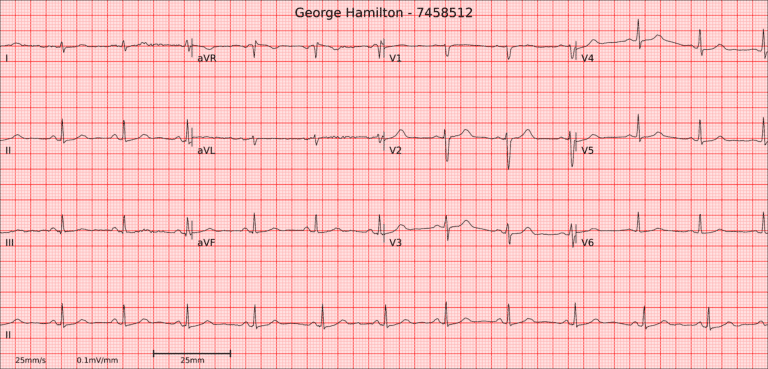EKG (ECG) Interpretation
This is the EKG (ECG) for George Hamilton from scenario SIE001US

Clinical Picture
- 28-year-old man presenting with mild central chest pain after lifting weights at the gym.
- No previous cardiac or respiratory issues, no evident risk factors.
- Looks well, normal vital signs, normal physical examination.
Findings
- Rate: 75
- Rhythm: Regular
- Axis: Normal
- Waves and intervals: No abnormality
Summary
- This is a normal EKG, demonstrating no pathology
Differential diagnosis
- In a young healthy patient with no significant medical background who presents after a period of increased physical activity and has a normal EKG, the most likely differential is musculoskeletal chest pain. A myocardial infarction is likely to give pain of a different nature, is rare in someone of George’s age and is likely to be evident on an EKG. A pneumothorax tends to present with sharp pain, shortness of breath and the patient may have unequal breath sounds on examination. Pericarditis is likely to present over a period of days, often with a prodromal illness and is usually evident on an EKG. Finally George has no history of reflux or gastric problems and the pain is not associated with food or eating, making gastrointestinal reflux less likely.
Management
- In this case simple analgesia and advice would be all that is needed.
- Note that a normal EKG does not exclude abnormal pathology – if the patient had concerning symptoms, additional investigation may be indicated.
Further reading
References
- Wagner, P., Strodthoff, N., Bousseljot, R., Samek, W., & Schaeffter, T. (2020). PTB-XL, a large publicly available electrocardiography dataset (version 1.0.1). PhysioNet
- Wagner, P., Strodthoff, N., Bousseljot, R.-D., Kreiseler, D., Lunze, F.I., Samek, W., Schaeffter, T. (2020), PTB-XL: A Large Publicly Available ECG Dataset. Scientific Data
- Goldberger, A. et al. (2000). PhysioBank, PhysioToolkit, and PhysioNet: Components of a new research resource for complex physiologic signals. Circulation [Online]. 101 (23), pp. e215–e220.